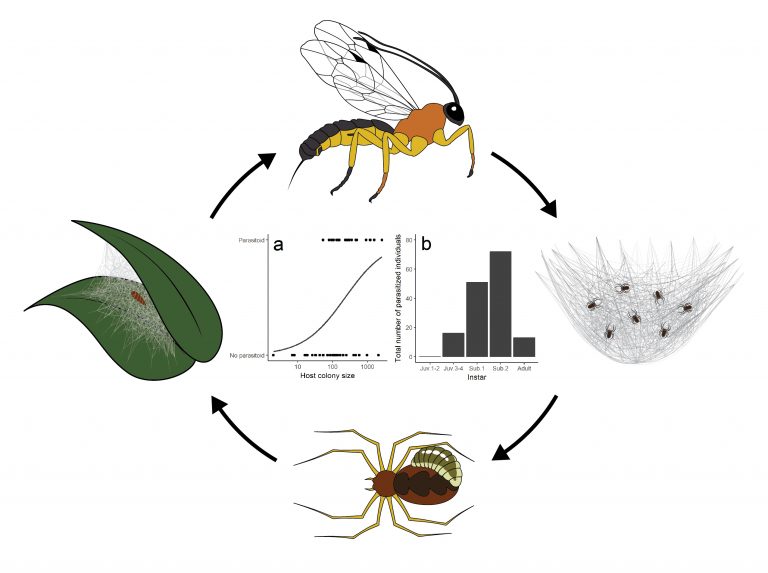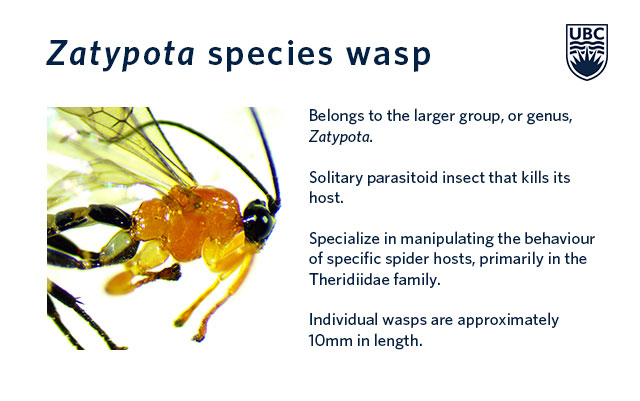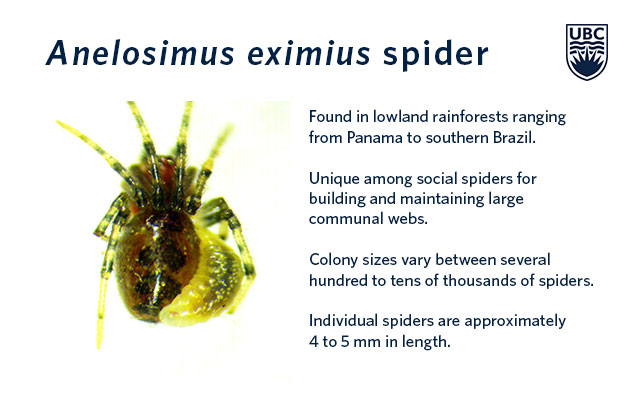It sounds like the plot of the world’s tiniest horror movie: deep in the Ecuadorian Amazon, a newly discovered species of wasp transforms a “social” spider into a zombie-like drone that abandons its colony to do the wasp’s bidding.
That’s the gruesome, real-life discovery by University of British Columbia researchers, who detail the first example of a manipulative relationship between a new Zatypotaspecies wasp and a social Anelosimus eximius spider in a study published recently in Ecological Entomology.
“Wasps manipulating the behaviour of spiders has been observed before, but not at a level as complex as this,” said Philippe Fernandez-Fournier, lead author of the study and former master’s student at UBC’s department of zoology. “Not only is this wasp targeting a social species of spider but it’s making it leave its colony, which it rarely does.”
Fernandez-Fournier was in Ecuador studying different kinds of parasites that live in the nests of Anelosimus eximius spiders, one of only about 25 species of “social” spiders worldwide. They are notable for living together in large colonies, cooperating on prey capture, sharing parental duties and rarely straying from their basket-shaped nests.
When Fernandez-Fournier noticed that some of the spiders were infected with a parasitic larva and spotted them wandering a foot or two away from their colonies to spin enclosed webs of densely spun silk and bits of foliage, he was puzzled. “It was very odd because they don’t normally do that, so I started taking notes,” he said.
Intrigued, he carefully took a few of the structures, known as “cocoon webs” back to the laboratory to see what would emerge from the depths.
To his surprise, it was a wasp.
“These wasps are very elegant looking and graceful,” said Samantha Straus, co-author of the study and PhD student in UBC’s department of zoology. “But then they do the most brutal thing.”
Using data gathered in Ecuador for different projects between 2012 and 2017, the researchers began to piece together the life cycle of the wasp and its parasitic relationship to the spider.

What they found was equal parts fascinating and horrifying: after an adult female wasp lays an egg on the abdomen of a spider, the larva hatches and attaches itself to its hapless arachnid host. It then presumably feeds on the spider’s blood-like haemolymph, growing larger and slowly taking over its body. The now “zombified” spider exits the colony and spins a cocoon for the larva before patiently waiting to be killed and consumed. After feasting on the spider, the larva enters its protected cocoon, emerging fully formed nine to eleven days later.
In other similar instances of parasitism, wasps are known to target solitary species of spiders like orb weavers and manipulate them into behaviours that are within their normal repertoire.
“But this behaviour modification is so hardcore,” said Straus. “The wasp completely hijacks the spider’s behaviour and brain and makes it do something it would never do, like leave its nest and spinning a completely different structure. That’s very dangerous for these tiny spiders.”
It’s not known how the wasps do this, but scientists believe it may be caused by an injection of hormones that make the spider think it’s in a different life-stage or cause it to disperse from the colony.
“We think the wasps are targeting these social spiders because it provides a large, stable host colony and food source,” said Straus. “We also found that the larger the spider colony, the more likely it was that these wasps would target it.”
Straus, who now sports a tattoo of the wasp, will return to Ecuador to investigate whether the wasps return to the same spider colonies generation after generation and what evolutionary advantage that might present.
Meanwhile, the wasps will likely continue their starring role in the spiders’ worst nightmares.






